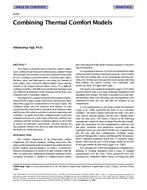Description
Two models commonly used in thermal comfort studies were combined to develop a two-dimensional computer model that estimates the resistance to dry and evaporative heat transfer for a clothing system from fabric resistance data, fabric thickness data, and information concerning the amount of body surface area covered by different fabric layers and the amount of air trapped between fabric layers. Five different clothing ensembles with different total thermal insulation and very different distributions of the insulation on the body were simulated with 16 sedentary subjects. This paper first evaluates total thermal insulation predictions from the Fanger steady-state model and then uses these data in the Gagge two-compartment (or two-node) model. The combined model uses the transient heat balance of each segment and the whole body. It estimates total insulation value and then uses this value to calculate transient temperature and wettedness. By application of the combined model, predictions of human responses to a wide range of thermal conditions are compared with the responses of human subjects as described in reports of laboratory experiments. Possible reasons for discrepancies between the observed data and predictions of the model are briefly discussed.
Units: SI
Citation: ASHRAE Transactions, vol. 105, pt. 1
Product Details
- Published:
- 1999
- Number of Pages:
- 8
- File Size:
- 1 file , 280 KB
- Product Code(s):
- D-7524




